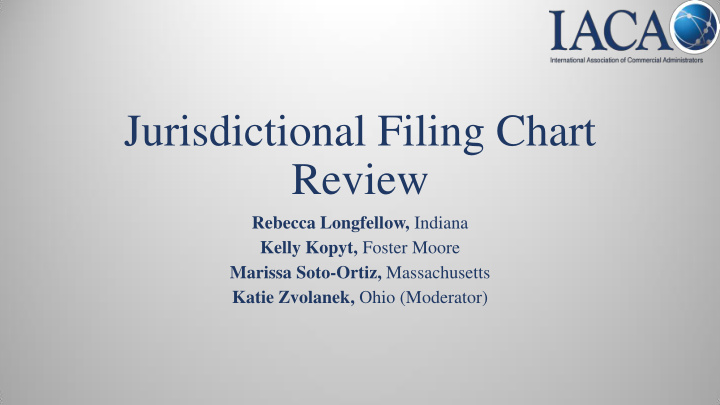



Jurisdictional Filing Chart Review Rebecca Longfellow, Indiana Kelly Kopyt, Foster Moore Marissa Soto-Ortiz, Massachusetts Katie Zvolanek, Ohio (Moderator)
Introducing Filing Chart 2020
1. Addition of Electronic Filing System Differences • List where e-filing systems might behave differently than stated action for paper filings • This column is not meant to say “e - filing prevents this issue” but rather to show when e-filing behaves differently than paper practice. • 70-80% of filings are now done online – how does this chart need to evolve to capture this reality? • Who is still filing on paper? Do we want to encourage more online filing?
2. Address info at the Beginning of the Chart • On past versions of the chart, jurisdictions tended to be less likely to reject for missing zip, city, state, etc. for secured party addresses • Now, responses indicate that address info for debtor and secured party is treated the same • Combined into one spot on the chart to save space and to locate easily.
3. UCC1 – Section 1&2 Checkbox scenarios • Before, there were about 10 different scenarios surrounding whether the box was checked or not – but it doesn’t actually matter • Complete information is required in all debtor fields in order for the debtor to be indexed. • The box is meant to alert the person processing that there is info on the following page • It should not affect how data is entered
4. Assumption 5 addition • Several scenarios recommend “Accept as to Debtor 1 but not Debtor 2.” • If a filing is partially accepted, it is important to alert the filer that not all debtors were indexed. NEW!!!
5. Removed “no boxes checked”/ “Accept” scenarios • These were areas where, more often than not, boxes are not checked. • The more important question: “What do we do if the boxes are checked?” So those scenarios are left and removed the “no boxes checked” scenarios. • Examples:
6. Amendment Combinations • Added a section to differentiate between paper filings and online filings • If the answer is “no” to acceptance, don’t need to fill out the rest of the section! • If an amendment combination is presented, but an office does not accept combos, does the office reject the whole document or accept as to one and not the other? • If the latter, which one does the office accept? And how does it alert the filer that it was only partially accepted?
7. Are you the only one in the deviation column? • If you are the only jurisdiction that rejects when everyone else accepts, do you need to re-evaluate that response?
8. Should it be rejected? • What is the statutory reason for rejecting? • If the rejection reason isn’t found in 9 -516, does the jurisdiction have a supplementary statute/rule authorizing rejection? • If the answer is reject because of system limitations, do you have plans to correct your system?
9. Section 8 of UCC3 – Collateral Change • In section 8, many jurisdictions reject if the filer provides info without checking a box, or if the filer checks all the boxes: • How is this different from UCC1, 4a, where filer fails to provide any info in item 4? These same jurisdictions accept this scenario: • What is the rejection reason on the UCC3?
10. Refusal Errors/Filing Office Errors • Updated these recommended actions to include in both circumstances, a filing officer statement is necessary
Filing Office Errors – It Happens!
Two Types of Errors • Refusal Errors • Reject a document that should have been accepted • Or even acceptance errors – accept something that should have been rejected • Entry Errors • Enter data incorrectly into the information management system • Handle each one the same – A Filing Office Statement • Document, document, document. • If the record is changing, a filing office statement should be placed on the record to show the date of the change and explain what changed
Filing Office Statement Examples
Recommend
More recommend